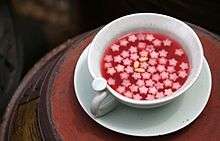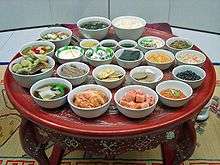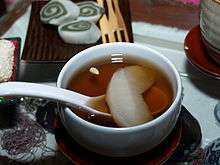Hwachae
| Hwachae | |
 Omija hwachae | |
| Korean name | |
|---|---|
| Hangul | 화채 |
| Hanja | 花菜 |
| Revised Romanization | hwachae |
| McCune–Reischauer | hwach'ae |
Hwachae (Korean pronunciation: [hwatɕʰɛ]) is a general term for Korean traditional punches made with various fruits or edible flower petals soaked in omija (Schisandra chinensis berries) or honeyed juice.[1][2]
Types
Omija hwachae (오미자화채 五味子花菜) is a hwachae made with omija (Schisandra chinensis berries) and various fruits or flower petals and also used as a basic juice for other varieties of hwachae.

Baehwachae
Fruits
| Baehwachae | 배화채 | Behwachae consists of flower-shaped bae (Korean pear) and omija juice.[3] |
| Baesuk | 배숙 | Baesuk is made by poaching slices of Korean pear with ginger, and black peppercorns, and sugar.[4] |
| Subak hwachae | 수박화채 | Subak hwachae is made with watermelon and other fruits. It is good for cooling hot temperature in summer. Watermelon is cut into half pieces and with a melon baller, the interior flesh is scooped out. The hollow rind is stuffed with the watermelon balls, its juice, other fruits, and ice.[1] |
| Yuja hwachae | 유자화채 | Yuja hwachae is made with thinly shredded yuja, Korean pear and sugar.[5] |
| Milgam hwachae | 밀감화채 | Milgam hwachae is a local specialty of Jeju-do made with citrus harvested in summer.[6] |
| Ttalgi hwachae | 딸기화채 | Ttalgi hwachae is made with strawberries.[1] |
| Bokbunja hwachae | 복분자화채 | Bokbunja hwachae is made with bokbunja (복분자 Korean black raspberries) and honey |
| Aengdu hwachae | 앵두화채 | Aengdu hwachae consists of Korean cherries soaked in honey or sugar dissolved water.[7] |
| Boksunga hwachae | 복숭아화채 | Boksunga hwachae is made with marinated peach with sugar.[8] |
| Mogwa hwachae | 모과화채 | Mogwa hwachae is made with mogwa (모과 Chinese quince), citrus, and sugar.[9] |
Flowers and plants
| Jangmi hwachae | 장미화채 | Jangmi hwachae is made with rose petals, mung bean starch and omija.[10] |
| Jindallae hwachae | 진달래화채 | Jindallae hwachae is made with azalea (Rhododendron mucronulatum)[11][12] petals, mung bean starch and is prepared for Samjinnal (삼짇날, a Korean traditional holiday which falls on every March 3 in lunar calendar).[13] |
| Songhwa hwachae | 송화화채 | Songhwa hwachae is made with songhwa garu (송화가루, dried pollen flour of pine tree) diluted in omija, or honeyed or sugar punch. It is a local specialty of Gangwon Province.[14] |
| Songhwasu | 송화수 | Songhwasu is made with songhwa garu in honeyed juice.[15][16] |
| Sunchae hwachae | 순채화채 | Sunchae hwachae is made by parboiling sunchae (순채, Brasenia schreberi) coated with mung bean starch and pouring honeyed juice or omija juice to the cooked vegetable.[17] |
Tteok and grains
| Sudan | 수단 (水團) | Sudan is a hwachae with gyeongdan (경단 a variety of tteok in ball shape) in honeyed juice.[18] |
| Tteoksudan | 떡수단 | Tteok sudan is made with thinly sliced garaetteok (tubed rice cake), mung bean starch, and honey.[19] |
| Borisudan | 보리수단 | Borisudan is made with steamed barely, mung bean starch, and omija juice.[20] |
| Wonsobyeong | 원소병 (圓小餠) | Wonsobyeong is made with ball-shaped tteok with fillings of minced jujube or citrus jam floated in honeyed juice.[21] |
| Changmyeon | 창면 | It is a cool dessert for summer, consisting of noodles made with mung bean starch and omija juice.[22] |
| Hwamyeon | 화면 (花麵) | Hwamyeon is a cool noodle sou almost similar to changmyeon except the addition of edible flower petals.[23] |
See also
References
- 1 2 3 "Kind of Eumcheongryu". Hwachae (Honeyed juice mixed with fruits). Korea Agro-Fisheries Trade Corporation. Archived from the original on 2009-04-15. Retrieved 2008-05-21.
- ↑ "Hwachae; Refreshing Beverage to Beat the Summer Heat" (PDF). Koreana. 2005. Retrieved 2013-04-25.
- ↑ "Baehwachae (배화채)" (in Korean). Doosan Encyclopedia. Retrieved 2013-04-25.
- ↑ "Baesuk (배숙)" (in Korean). Doosan Encyclopedia. Retrieved 2008-05-19.
- ↑ "Yujaz hwachae (유자화채)" (in Korean). Doosan Encyclopedia. Retrieved 2013-04-25.
- ↑ "Milgam hwachae (밀감화채)" (in Korean). Doosan Encyclopedia. Retrieved 2013-04-25.
- ↑ "Aengdu hwachae (앵두화채)" (in Korean). Doosan Encyclopedia. Retrieved 2013-04-25.
- ↑ "Boksunga hwachae (복숭아화채)" (in Korean). Doosan Encyclopedia. Retrieved 2013-04-25.
- ↑ "Mogwa hwachae (모과화채)" (in Korean). Doosan Encyclopedia. Retrieved 2013-04-25.
- ↑ "Jangmi hwachae (장미화채)" (in Korean). Doosan Encyclopedia. Retrieved 2013-04-25.
- ↑ "진달래, Korean rosebay, Rhododendron mucronulatum" (in Korean). Doosan Encyclopedia. Retrieved 2013-04-25.
- ↑ Rhododendron mucronulatum
- ↑ "Jindallae hwachae (진달래화채)" (in Korean). Doosan Encyclopedia. Retrieved 2013-04-25.
- ↑ "Songhwa hwachae (송화화채)" (in Korean). Doosan Encyclopedia. Retrieved 2013-04-25.
- ↑ 조선시대 궁중 태교음식 (in Korean). Hyundae Buddha Media Center. 2005. Retrieved 2008-05-21.
- ↑ 이신화 (2005). 우거진 신록, 빼어난 수바위 암봉에 취해 마시는 송화밀수 차 한잔 (in Korean). The Association of Korea Travel Writer. Retrieved 2008-05-21.
- ↑ "Sunchae hwachae (순채화채)" (in Korean). Doosan Encyclopedia. Retrieved 2013-04-25.
- ↑ "Sudan (수단 水團)" (in Korean). Doosan Encyclopedia. Retrieved 2008-05-21.
- ↑ "Tteoksudan(떡수단)" (in Korean). Doosan Encyclopedia. Retrieved 2013-04-25.
- ↑ "Borisudan (보리수단)" (in Korean). Doosan Encyclopedia. Retrieved 2013-04-25.
- ↑ "Wonsobyeong (원소병 圓小餠)" (in Korean). Doosan Encyclopedia. Retrieved 2013-04-25.
- ↑ "Changmyeon (창면)" (in Korean). Doosan Encyclopedia. Retrieved 2013-04-25.
- ↑ "Hwamyeon (화면 花麵)" (in Korean). Doosan Encyclopedia. Retrieved 2013-04-25.
- "Hwachae (화채 花菜)" (in Korean). EncyKorea. Retrieved 2008-05-21.
- "Kind of Eumcheongryu". Hwachae (Honeyed juice mixed with fruits). Korea Agro-Fisheries Trade Corporation. Retrieved 2008-05-21.
- Yoon Sook-ja (2005). "Hwachae: Refreshing Beverage to Beat the Summer Heat". Koreana / The Korea Foundation. Retrieved 2008-05-21.
External links
| Wikimedia Commons has media related to Hwachae. |
- (Korean) Types of Eumcheongnyu (Korean cold beverages) at KOSNET
- (Korean) List of Eumcheongnyu at the Korean Traditional Food Resource Portal
 |
| This article is part of a series on |
| Korean cuisine 한국 요리 조선 료리 |
|---|
|
Staples |
|
|
This article is issued from Wikipedia - version of the 9/12/2016. The text is available under the Creative Commons Attribution/Share Alike but additional terms may apply for the media files.

